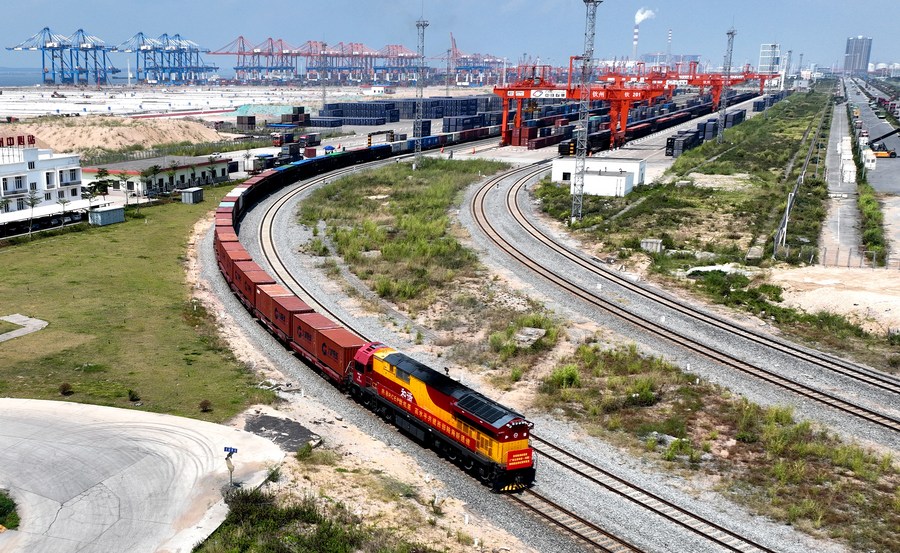
This aerial photo taken on Sept. 17, 2022 shows a freight train departing from Qinzhou Port in Qinzhou, south China's Guangxi Zhuang Autonomous Region. (Xinhua/Zhang Ailin)
BEIJING, Jan. 16 (Xinhua) -- Chinese provinces have set robust 2023 targets for major economic indicators from GDP to retail sales, setting an upbeat tone for the economic recovery from the COVID-19 shadows.
The 2023 GDP growth targets range from 4 to 9.5 percent for China's provincial-level regions. More than half of them expect their GDP to grow by 6 percent or higher, according to government work reports delivered at the annual sessions of the local people's congresses.
Hainan, a southern island province and a tourist hotspot, targeted the GDP growth at 9.5 percent, the highest among Chinese provincial regions, as it expects a strong revival of its tourism this year.
Among the highest goals are also those by Tibet Autonomous Region and Xinjiang Uygur Autonomous Region, which have anticipated their GDP to grow at 8 percent and 7 percent, respectively, in 2023.
Economic heavyweights such as Guangdong, Jiangsu, and Zhejiang mostly set GDP targets at 5-6 percent, as these provinces boast bigger economic sizes and are focusing more on improving quality, experts said.
The southern manufacturing heartland Guangdong province, whose GDP accounts for about one-tenth of the country's total, set a GDP growth target of at least 5 percent for 2023.
Shanghai, a financial hub in east China, expects to notch a year-on-year GDP growth of over 5.5 percent this year.
Many provinces have significantly raised their 2023 GDP goals from their 2022 estimates, bolstered by the recalibration of China's COVID-19 approach, said Pan Helin, a researcher at Zhejiang University.
Central Chinese provinces of Hunan and Hubei, for instance, have both set their 2023 GDP growth targets at 6.5 percent after estimated growths of 4.5 percent and 4.7 percent last year.
"Apparently, Chinese local governments have greater confidence and higher expectations for economic development in 2023," Pan said.
CONSUMPTION HIGHLIGHTED
In their 2023 agendas, many provinces have highlighted the digital economy as a powerful engine for realizing their ambitious goals.
Guangdong, for instance, plans to push forward the digital transformation of 5,000 industrial enterprises above a designated size, referring to industrial firms with an annual business turnover of at least 20 million yuan (about 3 million U.S. dollars), said its government work report.
Hubei has proposed to speed up the construction of digital industry clusters, such as artificial intelligence, supercomputer services, and aerospace information.
Robust growth in total retail sales is another common goal for Chinese provinces that expect consumption to shake off the COVID-19 pall. Fujian, Hainan, and Yunnan expected their total retail sales to increase by 10 percent or above this year.

People dine at a restaurant in Beijing, capital of China, Jan. 1, 2023. (Xinhua/Ren Chao)
Beijing, which has set a GDP growth target of over 4.5 percent for 2023, has vowed to further spur consumption amid its efforts to facilitate growth recovery.
"Restoring and expanding consumption should take precedence," said the city's acting mayor Yin Yong as he delivered the government work report on Sunday.
"Although the priorities of the growth-stabilizing measures vary from place to place, all localities regard boosting consumption as an important step to achieve this year's economic growth target," said Peng Jiqiu, former chair of the federation of industry and commerce of Changsha.
A string of indexes and data have shown that sectors ranging from tourism to services and catering are returning to their pre-pandemic levels after China relaxed or lifted many COVID-19 restrictions.
An index tracking shopper's foot traffic in 83 cities across the nation came in at 96.6 on Dec. 31, 2022, climbing 28.7 points from the lowest level in the same month, data from the State Information Center showed.




 A single purchase
A single purchase









